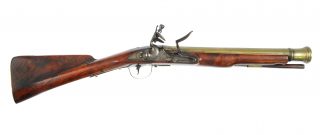 Few weapons inspire imagination about the sounds of a Revolutionary War battlefield like a blunderbuss. The name blunderbuss comes from the Dutch word donderbus, which translates to “thunder box”—an accurate description of the surprisingly explosive effect this gun created. A precursor to the shotgun, the flintlock blunderbuss was often issued to cavalry or naval troops for use in close-quarter combat. With a short, large-caliber barrel just shy of fifteen inches and a flared muzzle, the blunderbuss was best for use at short range, to scatter shot or other damaging projectiles.
Few weapons inspire imagination about the sounds of a Revolutionary War battlefield like a blunderbuss. The name blunderbuss comes from the Dutch word donderbus, which translates to “thunder box”—an accurate description of the surprisingly explosive effect this gun created. A precursor to the shotgun, the flintlock blunderbuss was often issued to cavalry or naval troops for use in close-quarter combat. With a short, large-caliber barrel just shy of fifteen inches and a flared muzzle, the blunderbuss was best for use at short range, to scatter shot or other damaging projectiles.
In August 2017 the Institute acquired this fine eighteenth-century blunderbuss, a type that was carried by British troops during the American Revolution. It was made commercially in London, ca. 1770-1780, and would have been purchased by the British government or individual units for distribution to its men. The brass barrel bears two oval London Gunmaker’s Company private proof markings, and the lockplate is marked “TOWER” along with a crown over “GR” next to a broad arrow mark. The tapered wood ramrod terminates in a small metal worm, a corkscrew-shaped tool used to clean the inside of the barrel.
See more information about this firearm in the Institute’s online museum collections database.
View More Armaments